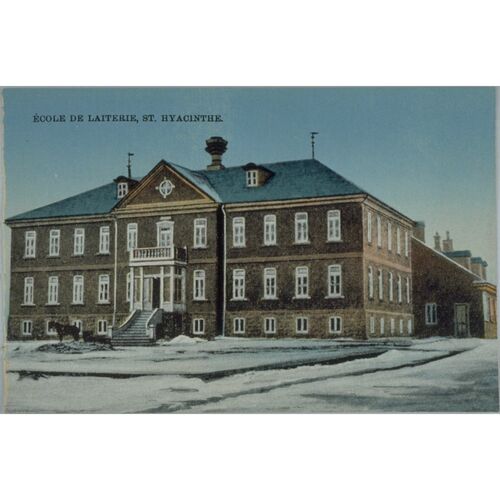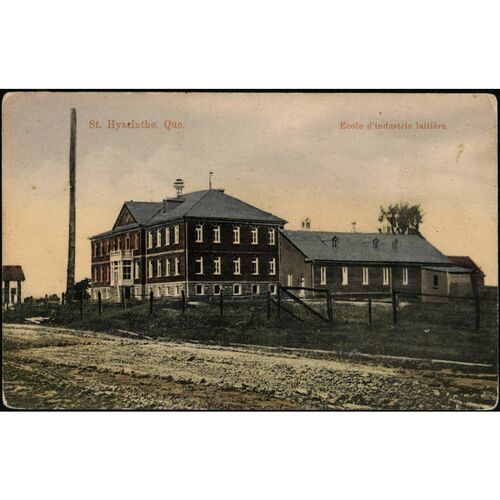BOURBEAU, ÉLIE, cheese manufacturer, farmer, teacher, inspector, politician, office holder, and technical-school principal; b. 31 Aug. 1864 in Saint-Césaire, Lower Canada, son of Magloire Bourbeau, a farmer, and Marie Gaudreau; m. there 14 Feb. 1887 Amanda Tétreau-Ducharme, and they had 13 children, 10 of whom survived him; d. 18 July 1934 in Saint-Hyacinthe, Que., and was buried there on 20 July.
Little is known about Élie Bourbeau’s early years, except that the only schooling he received was at the elementary school in his village. After serving an apprenticeship in a cheese factory in 1883–84, he bought one for himself in Saint-Césaire in 1884, and sold it in 1889. A little later that year he acquired another one, located in Canrobert (Ange-Gardien). He disposed of it in March 1893, but it was ceded back to him in December for unknown reasons and would remain in his possession until 1901. Dynamic and inventive, he carried out experiments in his factories on the production and maturation of cheese as well as on the method of storing silage.
From the outset, Bourbeau took pains to improve the quality of his cheese and the efficiency of production methods. Thus in 1886 he became a member of the Industrial Dairy Society of the Province of Quebec [see Édouard-André Barnard*; Théophile Montminy*]. This organization, which had been founded in 1882, sought to help the dairy industry solve persistent problems related to the quality and marketing of the cheese and butter produced in Quebec. Bourbeau regularly attended its annual meetings and over time became one of its valued lecturers, sharing the results of his experiments. In 1887 he visited one of the factories of David Murdoch Macpherson*, a large-scale Ontario cheese producer, to study his working methods. Moreover, in 1893, he was a member of the initial class of 214 enrolled at the new Dairy School in Saint-Hyacinthe [see Omer-Edmond Dalaire*]. At the end of the year he was granted a diploma as inspector of cheese factories by the school.
The year 1894 was a significant one in Bourbeau’s career. For one thing, he became a teacher of cheese production at the Dairy School at Saint-Hyacinthe, thus beginning a long connection with this institution that would continue until his death in 1934. In addition he was appointed assistant inspector general of butter- and cheese-factory syndicates by the Industrial Dairy Society of the Province of Quebec. The statute enacted in 1890 that had amended the law respecting this organization governed its establishment of syndicates encompassing a certain number of cheese and butter factories within a given region. By joining a syndicate, the factories agreed to allow their products to be examined by the society’s inspectors, whose salaries they and the provincial government would share equally in paying.
In 1896 Bourbeau replaced Peter McFarlane as inspector general of cheese-factory syndicates, a position he would retain until 1921. He was also inspector general of butter-factory syndicates from 1896 to 1899 and from 1919 to 1921. In these roles, he supervised the service of inspection of factories, allocated the work among the inspectors, and kept the resulting statistics up to date. He also wrote an annual report to the Industrial Dairy Society of the Province of Quebec. He made his most important contribution in this office by helping to reorganize the inspection system in 1915. Following the entry into force that year of a provincial law providing for the compulsory inspection of butter and cheese factories, the society created five districts. Each district was put under the supervision of a deputy inspector general and separated into ten divisions on average, with a local inspector made responsible for each one. According to Bourbeau’s report to the minister of agriculture in 1915, this reform led to a definite improvement in the inspection of cheese factories in the province. Under a law enacted in 1921, the Department of Agriculture assumed official responsibility for the inspection of cheese and butter factories, which had been carried out until then by the Industrial Dairy Society. Bourbeau now became inspector general of butter and cheese factories for the province and head of the ministry’s dairy branch. He would retain these offices until 1928.
Besides working with the association, Bourbeau also helped found the Société Coopérative Agricole des Fromagers de Québec [see Joseph-Édouard Caron*] in 1910. Within it, he was, in particular, responsible for evaluating and classifying cheese. The society’s objectives were to reform the traditional system of selling it in the province and to convince producers of the importance of improving the quality of their cheeses, including those intended for export.
On 1 March 1928 Bourbeau became the fifth principal of the Dairy School at Saint-Hyacinthe. This appointment was the crowning achievement of his career. During his term of office he updated a number of courses on cheese production and established a department to do research on ice cream, a product in increasing demand at the time. His main accomplishment, however, was the renovation of the school, which was carried out from 1931 to 1933. This work included, among other things, the modernization of the butter factory and the establishment of a new bacteriology laboratory, cold room, and pasteurization and homogenization complex. The arable land owned by the school was increased by 55 acres and several buildings on the adjoining farm were enlarged.
Over the years, the expertise Bourbeau acquired in the field of cheese production became recognized. At the request of the Industrial Dairy Society of the Province of Quebec or the Department (later the Ministry) of Agriculture, he travelled several times to Ontario, England, and the United States to study the best methods of production. Moreover, he prepared an analysis of the papers on the manufacture of cheese that had been presented at the annual meetings of the society from its inception. This document came out in Quebec City in 1903 as a supplement to the society’s annual report, under the title “Fabrication du fromage.” He also had many articles on the cheese industry published in the Montreal journal Le Bulletin des agriculteurs in 1918–19. From 1907 to 1921 items by him appeared in Le Journal d’agriculture et d’horticulture, Le Journal d’agriculture et d’horticulture illustré, and Le Journal d’agriculture, the successive titles of the provincial Ministry of Agriculture’s official organ, published in Montreal.
Bourbeau’s activities were not confined to the dairy industry, however. From 1904 to 1911 he maintained apple orchards on a property he had bought near Mont Rougemont. In addition, he tried his hand at politics, serving as a municipal councillor for Saint-Hyacinthe from 1909 to 1914. He was also vice-president in 1919–20, and president from 1920 to 1923, of the Union Saint-Joseph de Saint-Hyacinthe [see Louis-Zéphirin Moreau*], a Catholic mutual-aid society that provided for its members in the event of illness or death.
Following a lengthy illness, Élie Bourbeau died around 2:00 a.m. on 18 July 1934, at the Saint-Hyacinthe Dairy School. He was one of the rural elite who had taken the initiative to modernize Quebec agriculture and had convinced the provincial government to assume its responsibilities in this regard. A true pioneer, he had devoted himself wholly to revitalizing the dairy industry in the province of Quebec and improving the quality of its rather mediocre products, especially cheese, at a time when this industry was being commercialized and becoming the mainstay of Quebec agriculture.
The author made use of the École de laiterie de Saint-Hyacinthe fonds at the Arch. de l’Instit. de Technologie Agroalimentaire (Saint-Hyacinthe campus, Que.). An autobiographical letter from Élie Bourbeau to John Archibald Ruddick, dated 20 June 1933, can be found there. The reports of the Ministry of Agriculture (whose titles vary over the years) for 1894–1935, as well as the reports of the Soc. d’Industrie Laitière de la Prov. de Québec from 1882 to 1901 and the joint reports of the latter institution with the dairy school at Saint-Hyacinthe from 1902 to 1935, were also consulted. The author wishes to thank Mme Annick Paul, archivist of the city of Saint-Hyacinthe, for her assistance.
BANQ-CAM, CE602-S9, 1er sept. 1864, 14 févr. 1887; CN602-S84, 23 déc. 1893; CN602-S97, 22 nov. 1884, 10 avril 1888, 25 févr. 1889. BANQ-E, CN502-S37, 11 nov. 1889, 18 mars 1893, 7 août 1901. Centre d’Hist. de Saint-Hyacinthe, CH131. Gestion Documentaire et Arch. de la Ville de Saint-Hyacinthe, 1212.06 (conseil municipal – procès-verbaux). Le Courrier de Saint-Hyacinthe, 20 juill. 1934; 30 avril, 7, 14, 27 mai 1975. Le Devoir, 18, 21, 31 juill. 1934. La Presse, 20 juill. 1934. L’agriculture, Esdras Minville, édit. (Montréal, 1944). Gilles Bachand, Une école de laiterie à Saint-Hyacinthe en 1892, pourquoi? (nouv. éd., Saint-Hyacinthe, 2002). Gilles Bachand et Joanne Burgess, “‘L’uniformité dans l’enseignement pour l’uniformité de nos produits laitiers’: l’École de laiterie de Saint-Hyacinthe,” Cap-aux-Diamants (Québec), no.71 (automne 2002): 24–28. BCF, 1931–32: 236. Suzanne Bédard, Histoire de Rougemont (Montréal, 1978), 148, 155. J.‑C. Chapais, “Notes historiques sur les syndicats de laiterie de Québec” and “Le passé, le présent et l’avenir de l’industrie laitière,” Soc. d’Industrie Laitière et École de Laiterie de la Prov. de Québec, Rapport (Québec), 1914: 238–45, and Rapport, 1907: app., 1–46. Ruth Dupré, “Regulating the Quebec dairy industry, 1905–1921: peeling off the Joseph label,” Journal of Economic Hist. (New York), 50 (1990): 339–48. Firmin Létourneau, Histoire de l’agriculture (Canada français) ([nouv. éd., Oka, Québec], 1968). Normand Perron, “Genèse des activités laitières, 1850–1960,” in Agriculture et colonisation au Québec: aspects historiques, Normand Séguin, édit. (Montréal, 1980), 113–40. J. A. Ruddick, “The development of the dairy industry in Canada,” in The dairy industry in Canada, ed. H. A. Innis (Toronto, 1937), 13–123. Soc. de Pomologie et de Culture Fruitière de la Prov. de Québec, Rapport (Québec), 1904–5. Jean Tétrault, “Élie Bourbeau, un pionnier de l’industrie fromagère à l’Ange-Gardien,” Par monts et rivière (Rougemont, Québec), 9 (2006), no.1: 15–18.
Cite This Article
Gilles Bachand, “BOURBEAU, ÉLIE,” in Dictionary of Canadian Biography, vol. 16, University of Toronto/Université Laval, 2003–, accessed December 31, 2025, https://www.biographi.ca/en/bio/bourbeau_elie_16E.html.
The citation above shows the format for footnotes and endnotes according to the Chicago manual of style (16th edition). Information to be used in other citation formats:
| Permalink: | https://www.biographi.ca/en/bio/bourbeau_elie_16E.html |
| Author of Article: | Gilles Bachand |
| Title of Article: | BOURBEAU, ÉLIE |
| Publication Name: | Dictionary of Canadian Biography, vol. 16 |
| Publisher: | University of Toronto/Université Laval |
| Year of publication: | 2014 |
| Year of revision: | 2014 |
| Access Date: | December 31, 2025 |




